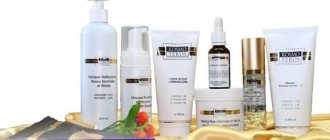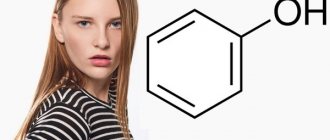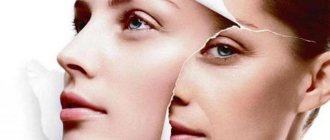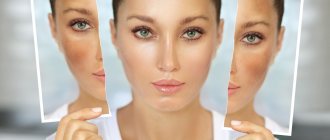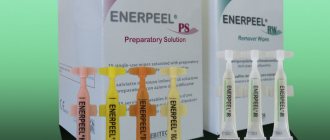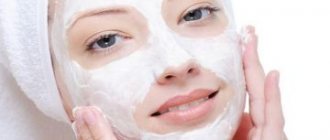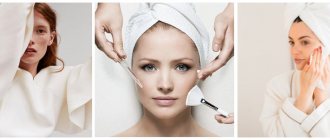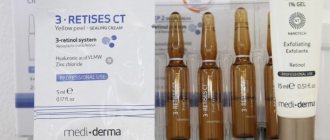Trichloroacetic acid TCA 15%, 25%, 35%
TCA peeling (Mediderma) - a classic medium peeling, is one of the main methods for correcting wrinkles and other age-related skin changes, as well as post-acne scars and stretch marks. Depending on the concentration of TCA peeling penetrates to different depths required in each specific case. This is an ideal peeling for local use in the area of creases and deep wrinkles, hyperpigmentation and various skin texture disorders.
Expected effect:
- intensive skin rejuvenation,
- smoothing out fine and deep wrinkles,
- relief leveling
- elimination of stretch marks, scars
- elimination of hyperpigmentation
Medium peeling usually requires pre-peeling preparation. This could be the home use of creams or lotions containing light exfoliating and renewing ingredients, such as fruit or AHA acids. With proper preparation, the skin is “trained” before the most aggressive impact, which will shorten the rehabilitation period, improve skin regeneration and get a more pronounced result. Also, to prepare the skin for medium peeling, it is recommended to first undergo 1-3 sessions of superficial peeling.
Complications
TCA peeling is a traumatic and painful procedure. If you ignore contraindications and do not properly care for your skin, the following complications may occur:
- if the patient had diseases of a herpetic nature, they may worsen;
- in some cases, keloid scars appear on the treated areas of the skin;
- hyperpigmentation of the epidermis begins;
- A noticeable boundary between skin structures (demarcation line) appears on the treated area.
How is the TCA peel procedure performed?
The TCA peel procedure is quite sensitive. When applied to the skin, a fairly intense burning sensation occurs after 1-2 minutes, but it passes quickly. Then the so-called “frost” forms on the skin - a white coating consisting of coagulated upper layers of the epidermis. It is practically invisible and easily washed off. TCA peeling may not be accompanied by any redness, so the patient does not observe any changes in the skin immediately after the procedure. However, a pronounced vascular reaction and slight swelling are also possible and depend on the individual characteristics of the skin. 2-3 days after the procedure, a dark crust forms in the peeling area, which completely disappears within 5-7 days. Young skin after the crust has peeled off is pink; over the course of several days it gradually acquires its normal color. It is very important to use sunscreen or avoid sun exposure altogether for at least two weeks to prevent pigmentation from forming in the peeling area.
Rules of behavior after the procedure:
- avoid thermal procedures (sauna, steam bath, hot shower) for 2 weeks after the procedure
- Avoid skin exposure to sunlight and use SPF 50 sunscreen
- Gently cleanse the skin; in case of severe tightness, use light moisturizers
- try to avoid strong tension and activity of the facial muscles, as this can lead to cracking of the crust and longer healing
The recommended course of TCA is 15%, 25%, 35% from 1 to 5 procedures, once every 1.5 - 2 months.
Indications and contraindications for use
Before making an appointment with a cosmetologist for a procedure, you must definitely go for a consultation with a dermatologist, who can objectively assess the condition of the skin and give related recommendations.
In addition, you need to familiarize yourself with the list of contraindications for this type of peeling.
INDICATIONS
- if the patient, as a result of natural age-related changes, has facial wrinkles in the area of the eyes, mouth, cheeks, forehead;
- to reduce excessive secretion of sebum and narrow enlarged pores;
- to remove the consequences of acne - keloids, scars, uneven skin;
- to eliminate stretch marks that appeared on the body after rapid weight loss or pregnancy;
- to reduce noticeable photoaging;
- to reduce visible age-related changes and restore the skin to its former youthful appearance.
This is an ideal procedure for getting rid of freckles, age spots, and acne marks.
CONTRAINDICATIONS
- Inflammatory processes in the area of skin to be treated. Violation of the integrity of this area of the epidermis.
- The presence of herpes infection in the body.
- Increased tendency to form keloid scars.
- Hyperpigmentation.
- Allergy or individual intolerance to any of the components of the cosmetic peeling composition.
- Pregnancy and lactation process.
- The presence of diseases of the endocrine system in the patient, any cancer, dermatological diseases.
- Taking vitamin A in large doses over the past six months.
- Recent tanning of the skin.
- A large number of moles.
- Excessive hair growth.
- Critical days.
- Carrying out procedures that injure the skin during the last 2 months (for example, enzyme, ferul, diamond peeling).
The effect of peeling with trichloroacetic acid depends on the depth of exposure of the active substance in the cocktail, the patient’s age, his level of health, the presence of bad habits and other factors.
Popular questions
I did the procedure, but there was no result. Why?
This happens if a person initially has false ideas about what the skin should look like after the procedure. You need to realize in time that each case under consideration is individual, which means that the result will manifest itself differently for everyone. For some, acne and scars will disappear immediately, for others the procedure will have to be repeated.
I noticed the appearance of white spots on my face. What is this?
This phenomenon is absolutely normal. It occurs if the cosmetologist applied a strong enough concentrated solution to the areas where the scars were located to eliminate them. After about six months, the skin will recover and the white spots will disappear. However, it is worth considering that sometimes the manifestation of such pigments occurs due to the death of cells that produce melatonin. Then the defect will remain for life.
I feel tightness after peeling. Why?
This phenomenon is considered an individual skin reaction to acid exposure. Some patients may indeed experience dry skin, and this is quite normal. To improve the condition of the epidermis, it is recommended to undergo mesotherapy or biorevitalization procedures.
I’m still preparing for the procedure, what sensations may arise?
The sensations manifest differently in each patient, but at low concentrations of acid, patients usually do not feel anything. If we talk about carrying out a procedure with the application of several layers or the use of high concentration acid, painful sensations may occur.
Feelings can vary significantly between two different people.
I would like to know about the disadvantages of such peeling. And why are there opponents among cosmetologists?
Chemical peeling, like any other, is considered a potentially risky procedure. In the case of TCA peeling, cosmetologists are wary of the use of concentrated acid. But it is worth noting that such a remedy in the hands of a professional will not harm the patient in any way, so there is no need to worry. In addition, if you trust an experienced specialist, the procedure will be painless, and the rehabilitation period will be under constant supervision.
To avoid possible risks, it is necessary to undergo an examination in advance by a professional cosmetologist, who will be able to determine the type and condition of facial skin, as well as select the appropriate concentration of the solution.
It is worth visiting a cosmetologist before procedures
Features of peeling at home
Trichloroacetic acid is a medicinal product and should not be used at home. It is impossible to independently control the frost effect in order to neutralize the effect of the acid composition. Only a specialist, after assessing the condition of the skin, will be able to prescribe the optimal composition of the exfoliant and select post-peeling care.
Important! For home care, you can use trichloroacetic acid at about 8%. It is not recommended to use the composition frequently; 2 sessions over 3 months are sufficient.
How the procedure is carried out:
- Wash off makeup, blot excess moisture with napkins.
- Using tonic, degrease the skin.
- Using cotton swabs, distribute the solution symmetrically along the massage lines, starting from the forehead, gradually moving to the chin. Avoid mucous membranes and the periorbital area.
- Keep the composition for no more than 3 minutes; to reduce discomfort, you can blow your face with a fan or fan.
- Then neutralize with a weak soda solution; the characteristic hissing is a normal reaction.
- Rinse with warm boiled water, apply a soothing cream or moisturizing mask.
Post-peeling care is no different from salon care; the recovery period coincides with the professional one. You can smear the skin with anti-inflammatory, regenerating creams and gels.
Possible side effects (5 troubles)
After this manipulation, in any case, you should expect redness of the skin, swelling, and you also need to be prepared for the skin to begin to peel off.
There have been cases where patients experienced pigmentation, scarring, and allergies. Basically, this happens if contraindications were not taken into account, or the person ignored the doctor’s recommendations.
Thus, after the procedure you may encounter the following troubles:
- Herpes. This problem appears for one simple reason: a person has a tendency to get frequent herpes, but he did not take a course of antiviral drugs at the preparation stage. In this case, you should consult a doctor who will prescribe the appropriate medications.
- Dark spots. They form if the procedure was carried out during a period of increased sun activity, preparation for peeling was not carried out, and the crusts were torn off.
- Acne. This often happens if the doctor chose the wrong session method. It is forbidden to lubricate acne with alcohol-containing products. Medicines against viruses and preparations containing zinc will come to the rescue.
- Allergy. To avoid it, you need to do allergy tests before the manipulation.
- Scars. They often form in those patients who have peeled off the crusts themselves.
If you're looking for an at-home alternative to TCA peels, then consider peels with glycolic, lactic, or salicylic acid. They can be bought in specialized stores. But it is better to first discuss this issue with a cosmetologist.
Dermatologist Ronald Shelton
Advantages and disadvantages
TCA peeling completely transforms your appearance, rejuvenating and brightening your face. The upper “old” and keratinized layer completely disappears, giving way to young and healthy cells.
Wrinkles, pimples and other imperfections disappear. Complete tissue renewal occurs without surgical intervention. Suitable for solving complex skin problems.
But this type of cleansing has many more disadvantages. The client should definitely weigh the pros and cons before undergoing such a serious procedure.
Among the many disadvantages are:
- high cost;
- painful procedure;
- the presence of many contraindications and complications;
- duration of preparation and rehabilitation;
- the need to take medications.
This is why few women decide to undergo chemical peeling. And, if this did happen, it was an absolutely informed decision with a willingness to take risks.
Precautionary measures
Exfoliation is a traumatic procedure and is performed only by an experienced, qualified cosmetologist on an outpatient basis.
Contraindications:
- pregnancy, lactation;
- oncology;
- herpes;
- diabetes;
- fungal diseases;
- bacterial lesions;
- chronic pathologies in the relapse stage;
- tendency to keloid scars;
- moles, papillomas, warts;
- thyroid diseases;
- violation of tissue integrity;
- fresh tan;
- viral infections;
- mental disorders.
Side effects:
- swelling in sensitive areas;
- persistent redness;
- dryness, feeling of tightness;
- the skin is peeling, intense peeling of the plates.
If the patient’s management protocol or rehabilitation rules are violated, the following complications are possible:
- dark pigmented or red spots, for prevention it is necessary to use sunscreens with the maximum SPF factor throughout the year;
- long-term persistent redness is observed in the presence of dilated superficial vessels;
- marbled skin, characterized by white spots, appears when scars and scars are smoothed;
- the demarcation boundary separates areas treated and untreated with acid composition;
- acne occurs against the background of an inflammatory process in problematic, oily skin types; to correct it, it is necessary to adjust the diet and select skincare products;
- increased sensitivity can still develop into pseudowrinkles; to eliminate the phenomenon, injections of hyaluronic acid are prescribed.
Preparation rules
The quality of the final result depends on the preliminary preparation, which the patient must carry out independently.
During the first consultation, the cosmetologist will give a reminder that details what needs to be done before acid cleansing.
Preparation begins no later than a month in advance and includes the following points:
- All medications should be discontinued. A few days in advance, you need to start taking anti-inflammatory drugs, if indicated by a doctor. You cannot prescribe medications yourself.
- Before going out, you must apply a protective cream with SPF to your face and neck.
- You cannot epilate, scrub the skin, or injure it with washcloths, sponges or cleansing brushes.
- For a couple of days, you should not visit a bathhouse or sauna, pluck your eyebrows, or squeeze out pimples.
- Before performing medium or deep peeling, experts recommend conducting a couple of superficial peeling sessions.
Also, to prepare the epidermis for serious exposure to chemical acid, two weeks before the expected session you need to start using skincare cosmetics that contain fruit acids in low concentrations.
What is the rehabilitation process?
Once the procedure is completed, the skin will begin to swell. Also among the rehabilitation symptoms may be dryness, soreness and tightness. After a couple of days, the patient will be able to notice the formation of a crust. To avoid the occurrence of keloid scars, it is better not to rip it off.
It will disappear on its own 7-8 days after a successful session.
Important ! When the crust subsides, renewed skin with a pleasant pinkish tint will come out. After a short amount of time (several days), the color of young skin will become less saturated.
During the first week of rehabilitation, the crust disappears
Carrying out
TCA peeling occurs in four main stages. Completion of each point is mandatory. A cosmetologist who skips any of the steps of the procedure is not a specialist in his field.
To protect your health, you need to ask your doctor in advance about the sequence of proposed manipulations.
Step 1
The epidermis is cleansed using special means. At this stage, antiseptics are mandatory, after which the person can be considered fully prepared for the application of trichloroacetic acid.
Step 2
A specialized preparation containing the required percentage of acid (from 25 to 35%) is applied successively in several layers.
The first layer is not felt by the patient at all; subsequent layers can cause moderate pain. Some cosmetologists use a fan to neutralize unpleasant sensations, which blows cool air onto the face.
The effectiveness of the manipulations is assessed visually. If a white coating begins to appear on the surface of the dermis, the procedure can be considered effective.
Step 3
The cosmetologist applies a drug that neutralizes the further effects of acid. Often, when a neutralizer and an acid preparation are combined, foaming begins.
This can be avoided by applying the product gradually. Then the remaining substances are removed with water.
Step 4
Applying thick moisturizing masks and creams. They protect the injured epidermis from external influences and prevent dirt and germs from getting on the face.
Skin care after the procedure
Complete restoration and renewal of the epidermis occurs after four weeks. At first, the face turns red and swells slightly; after a couple of days, crusts begin to form.
Attention! It is forbidden to remove them yourself! Such an action can cause difficult to correct aesthetic defects.
First week
The first 7 days require the most careful care. Moisturizing creams, emulsions or foams that contain Panthenol should be applied. This will promote rapid tissue regeneration.
You are allowed to wash your face only the next day after TCA peeling using products that do not contain fats. On the recommendation of a cosmetologist, you should use vitamin serums.
Second, third and fourth week
The next three weeks of recovery involve the use of moisturizing care. The procedure of mesotherapy and biorevitalization will be useful.
During rehabilitation it is prohibited:
- sunbathe;
- be exposed to heat;
- swim in a lake, pool;
- carry out other care procedures;
- drinking alcohol.
When all the crusts come off, the regeneration process can be considered complete. The result will be clearly visible in the mirror.
What medications should I take for recovery?
To quickly renew the skin and prevent some complications, the doctor will recommend a course of medications that must be taken for 2-3 weeks.
What a cosmetologist can advise:
- medicines for skin regeneration (Levamisole, Pyrogenal) - promote rapid renewal of the epidermis at the cellular level;
- vitamin complexes with zinc (Doppelgerts asset “from A to Zinc”, etc.) – the absence of this substance has a detrimental effect on skin health;
- ointment containing panthenol - heals microdamages;
- immunostimulating drugs (Immunal) – increase the body’s immunity.
Taking medications on your own is strictly prohibited. Ignorance of pharmaceuticals can have a detrimental effect on the health of not only the epidermis, but also the entire body.
All substances used should be discussed with a doctor, especially since the need for medications varies significantly in each individual case.
The essence of peeling
Over the years of use, exfoliation with trichloroacetic acid has undergone changes. Today, the composition of peeling solutions contains additional ingredients:
- Superficial - contains TCA from 5% to 15%, also includes fruit acids, saponins. A balanced composition allows you to enhance the depth of penetration of active components and activate microcirculation.
- Medium - a solution from 20% to 35% is used, in addition to acid, it includes amino acids that trigger regeneration processes. It is prescribed not only for correction of facial rejuvenation, but also used to get rid of scars and stretch marks on the body.
- Gluboky contains 40% trichloroacetic acid, as well as phytic, fruit acids and saponins, which soften the effect of the main component. It is used on certain areas of the face and body, improves the regenerative properties of the integument.
Attention! It is not recommended to use TCA peeling at home. You can only trust the procedure to a dermatocosmetologist or plastic surgeon. There are high risks of complications and side effects, which can only be prevented by an experienced, highly qualified specialist.
Is it worth going for the procedure?
The choice depends entirely on the patient. Some may not like the risk of pain during the TCA peel, and others may not be able to afford such a long recovery period for the skin. However, it is worth noting that there are quite a few positive reviews on the Internet indicating the high efficiency of using acid.
If in doubt, it is better to ask a doctor
TCA peeling is mainly recommended for patients whose age has passed the 35 year mark, when skin cell renewal has noticeably slowed down. Such a procedure in this case will have an extremely positive effect.
Important ! In any case, it is recommended to visit a cosmetologist so that he can help determine the need for TCA peeling and prescribe a certain concentration of acid.
Advantages and disadvantages
Despite its effectiveness and solution to a whole range of aesthetic problems, the procedure has a number of side effects. Patients should consider the main advantages and disadvantages.
Pros:
- controlled depth of exposure due to the frost effect - instant lightening of the integument;
- target areas are not only the face, but also the décolleté, neck, back, elbows, hips, buttocks, and abdomen;
- the result can be assessed after the first session;
- the exfoliant is easily distributed;
- the method is used for various age groups;
- improves skin structure, promotes rejuvenation;
- the pronounced effect persists for a long time;
- rapid recovery period when using solutions below 15%.
Minuses:
- a large list of contraindications;
- performed only in a salon by an experienced specialist;
- pre-peeling preparation is required;
- painful, traumatic procedure;
- high risks of complications;
- long rehabilitation periods when using acid more than 20%.
Glycolic exfoliation is painless and has a quick recovery period. Used to correct superficial wrinkles and pigmentation. As a result of the course, it is possible to normalize intracellular processes, remove toxins and oxidants. Used for patients under 35 years of age, for the care of thin, sensitive and problematic dermis.
Milk peeling allows you to care for sensitive skin prone to rosacea. Despite the all-season nature of the procedure, it is better to do it in the autumn-winter period to avoid pigmentation and irritation of the skin. Refers to gentle types of exfoliation.
Retinoic allows for superficial and medium peeling and has a multi-component composition. The description contains other fruit acids to achieve a whitening, anti-inflammatory, regenerating, rejuvenating effect.
Ferulic acid is used at 8% or 12% for superficial peeling. It is carried out both in winter and in summer, the seasonality depends on the composition. Suitable for skin care up to 40 years of age, after which more aggressive exfoliants are prescribed.
Action of acid
The mechanism of action of the substance allows us to draw a conclusion about the indications for the procedure. In other words, the substance allows you to obtain effects such as:
- cleansing Thanks to the acid, the upper layers of the epidermis are cleansed of impurities, making the skin soft and smooth;
- regeneration. Organic acid components affect the activity of skin cells, allowing them to grow as quickly as possible. Thus, if there are scars, scars or other visible damage on the body, after peeling they will begin to heal faster;
This peeling promotes skin regeneration - anti-inflammatory effect. After using acid, the pores narrow, which reduces the amount of fat secreted by the cells;
- stimulating effect. After the procedure, active production of collagen occurs, metabolic processes noticeably improve;
- antimicrobial action. Organic acid components actively fight flora that is unpleasant to the skin, preventing the risk of possible inflammation.
TCA peeling removes germs
Peeling effectiveness
To achieve the desired aesthetic goals, up to 2 sessions will be required with an interval of once every 30 days. As a result of application it is possible to achieve:
- rejuvenation, reduction of wrinkles;
- whitening pigmentation, freckles;
- smoothing scars, cicatrices;
- increasing elasticity and density of integument;
- restoration of healthy skin tone;
- oval lifting;
- reducing the synthesis of sebaceous secretions, normalizing the functioning of the glands;
- prevention of rashes and inflammatory processes;
- strengthening the immune properties of the skin.

